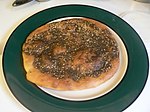This is an old revision of this page, as edited by Tastytreasures (talk | contribs) at 21:12, 9 June 2009. The present address (URL) is a permanent link to this revision, which may differ significantly from the current revision.
Revision as of 21:12, 9 June 2009 by Tastytreasures (talk | contribs)(diff) ← Previous revision | Latest revision (diff) | Newer revision → (diff)
Za'atar (Template:Lang-ar), also spelled satar, zahatar or zatr, is a mixture of herbs and spices used as a condiment with Middle Eastern and Levantine Arab origins. The name of the condiment shares the Arabic name of the herb used as the main ingredient.
Etymology

Latin names for the herbs called za'atar include Origanum majorana (sweet marjoram), Origanum syriacum (also known as Biblical hyssop, Syrian oregano and wild marjoram), and Thymus capitatus (thyme). Za'atar barri ("wild za'atar") is identified as Origanum vulgare which in English can refer to European oregano, oregano, pot marjoram, wild marjoram, winter majoram, and wintersweet. Both oregano and marjoram are closely related Mediterranean plants of the Labiatae family which also includes mint and sage, so it is unsurprising that these herbs are commonly used as substitutes for one another.
Spice mixture
Za'atar is generally prepared using ground dried thyme, oregano, marjoram, or some combination thereof, mixed with toasted sesame seeds, and salt. Some varieties may add savory, cumin, coriander or fennel seed. A Lebanese variety of Za'atar usually contains sumac berries, and has a distinct dark red color.
Geographical distribution
Za'atar is popular both in cooking and as a condiment in Armenia, Iraq, Israel, Jordan, Lebanon, Libya, Morocco, the Palestinian territories, Syria, and Turkey.
History
Za'atar has been used along with other spiced salts as a staple in Arab cuisine from medieval times to the present.
Za'atar has historical significance for Palestinians. For instance, in Politics of Food (2004), Lien and Nerlich explain how "Tastes, smells, plants and food are the anchors of memory, invoking a much wider context," noting that for Palestinian refugees, plants serve as signifiers of the house, village, and region from which they hailed.
For Israeli Jews, za'atar (Template:Lang-he) used to be an exotic treat associated with visits to Arab bakeries. Today, commercial production of the plant in Israel has made it "an integral element in Israeli cuisine." Some Israeli companies market it commercially as "hyssop" or "holy hyssop"; however, Hyssopus officinalis is never found in the wild in Israel, whereas Origanum vulgare is extremely common. According to the Israeli Ministry of Foreign Affairs, "wild hyssop" was on the verge of extinction due to over-harvesting and it was declared a protected species in 1977. The law "is considered almost anti-Arab" by Arab citizens of Israel who have picked wild herbs like za'atar for hundreds of years, learning from their ancestors how to preserve the yield of future years. A 2006 Israeli military order led to the confiscation of some za'atar from West Bank Palestinians at checkpoints.
Culinary use

Za'atar is used as a seasoning for meats and vegetables. It can be mixed with olive oil to make a spread called za'atar-wu-zayt as a dip for the sesame bread rings known as ka'ak. Za'atar can also be spread on a dough base and baked as a bread, in which case it is called manaeesh bi zaatar. It can be sprinkled on labneh (yogurt that has been drained until it becomes a tangy, creamy cheese), a combination that is common, for example, among Lebanese, Palastinians and Syrians. Za'atar can also be sprinkled on hummus. In Israel, it is often used on pizza, and is commonly distributed in packets along with a delivered pizza. It can be mixed with salt, rolled into balls and preserved in oil, or dried in the sun.
Medicinal use
In Lebanon, there is a belief that this particular spice mixture makes the mind alert and the body strong. For this reason, children are encouraged to eat a za'atar sandwich for breakfast before an exam. Maimonides (Rambam), a medieval rabbi and physician who lived in North Africa and Egypt, also prescribed za'atar for its health advancing properties.
See also
References
- Aliza Green. "Za'atar". CHOW. Retrieved 2008-03-09.
- Johannes Seidemann (2005). World Spice Plants. Berlin: Springer. p. 365. ISBN 3540222790.
- Sorting Origanum Names
- ^ Za'atar:On Language
- Margaret Roberts (2000). Margaret Roberts' A-Z Herbs: Identifying Herbs, How to Grow Herbs, the Uses. Struik. p. 83. ISBN 1868724999.
- Ghillie Basan (2007). Middle Eastern Kitchen. Hippocrene Books. p. 27. ISBN 0781811902.
- Dorothea Bedigian (2004). "History and Lore of Sesame in Southwest Asia" (abstract). Economic Botany. Volume 58, Issue 3: pp. 330–353. doi:10.1663/0013-0001(2004)058[0330:HALOSI]2.0.CO;2.
{{cite journal}}:|pages=has extra text (help);|volume=has extra text (help); Unknown parameter|month=ignored (help) - Marianne E. Lien, Brigitte Nerlich (2004). The Politics of Food. Berg Publishers. pp. 148, 149. ISBN 1859738532.
- ^ "Hyssop: Adding Spice to Life in the Middle East". Israel Ministry of Foreign Affairs. 1998-07-01.
- "Forbidden Fruit". Retrieved 2008-03-14.
- The Palestinians: It is the little things that make an occupation; Economist magazine, 20 January 2007, p.64
- "Recipes of the West Bank Olive Harvest". November 21 2007. Retrieved 2008-03-14.
{{cite web}}: Check date values in:|date=(help) - Terry Carter, Lara Dunston, Andrew Humphreys (2004). Syria & Lebanon. Lonely Planet. p. 68. ISBN 1864503335.
{{cite book}}: CS1 maint: multiple names: authors list (link) - Krishnendu Ray (2004). The Migrant's Table: Meals and Memories in Bengali-American Households. Temple University Press. p. 154. ISBN 1592130968.
- Joan Nathan (November 9 1996). "Diversity in the dining room helps ring in Israel's new year". Houston Chronicle. Retrieved 2008-03-09.
{{cite web}}: Check date values in:|date=(help) - Aglaia Kremezi. "Zaatar". Recipe Zaar.
- Za'atar Pita Bread recipe
External links
| Medicinal herbs and fungi | |
|---|---|
| Herbs |
|
| Fungi | |
| Regional practices | |
| Related subjects | |
| List of plants used in herbalism | |